
The Driskill, a Romanesque-style building completed in 1886, is the oldest operating hotel in Austin, Texas, United States, and one of the best-known hotels in Texas generally. The Driskill was conceived and built by Col. Jesse Driskill, a cattleman who spent his fortune constructing "the finest hotel south of St. Louis".

The West Baden Springs Hotel, formerly known as the West Baden Inn, is part of the French Lick Resort and is a national historic landmark hotel in West Baden Springs, Orange County, Indiana. It is known for the 200-foot (61 m) dome covering its atrium. Prior to the completion of the Coliseum in Charlotte, North Carolina, in 1955, the hotel had the largest free-spanning dome in the United States. From 1902 to 1913 it was the largest dome in the world. Listed on the National Register of Historic Places in 1974, the hotel became a National Historic Landmark in 1987. It is a National Historic Civil Engineering Landmark and one of the hotels in the National Trust for Historic Preservation's Historic Hotels of America program.

Hot Lake Hotel is a historic Colonial Revival hotel originally built in 1864 in Hot Lake, Union County, Oregon, United States. The hotel received its namesake from the thermal spring lakes on the property, and operated as a luxury resort and sanitorium during the turn of the century, advertising the medicinal attributes of the mineral water and drawing visitors worldwide. It is also the first known commercial building in the world to utilize geothermal energy as its primary heat source.
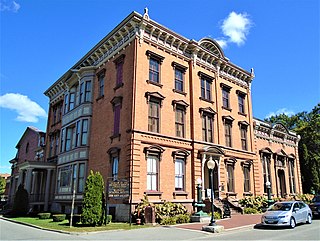
Canfield Casino and Congress Park is a 17-acre (6.9 ha) site in Saratoga Springs, New York, United States. It was formerly the site of the Congress Hotel, a large resort hotel, and the Congress Spring Bottling Plant, as well as Canfield Casino, which together brought Saratoga Springs international fame as a health spa and gambling site. At the peak of its popularity it was a place where the wealthy, major gamblers and stars of the entertainment world mingled. The park's artwork includes a statue by Daniel Chester French and landscape design by Frederick Law Olmsted, among others.
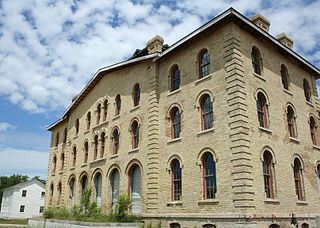
The Dousman Hotel, is a historic hotel located at the intersection of Fisher Street and River Road in Prairie du Chien, Wisconsin. The hotel was built in 1864–65 to serve railroad and steamboat travelers coming to the city. The hotel was named after Hercules L. Dousman, an early Wisconsin fur trader, land speculator and millionaire.

Horton Grand Hotel is a restoration of two historic hotels, the Grand Horton and the Brooklyn Kahle Saddlery, in downtown San Diego, California. The Horton-Grand was added to the National Register of Historic Places in 1980.
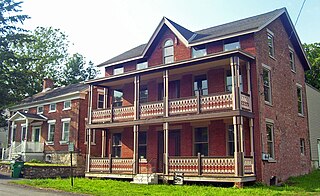
The Main Street Historic District in New Hamburg, New York, United States is located along that street just west of the train station. Six buildings on a single acre are an intact remnant of the hamlet as it was developed in the middle of the 19th century, prior to the Hudson River Railroad's construction, which cut it in half.

The Balch Hotel is a historic commercial lodging building in Dufur, Oregon, United States. It was built in 1907 by Charles Balch, a local land owner and businessman. The hotel has changed hands a number of times over the years, but it has remained in continuous use since it was constructed. Today, the Balch Hotel is an active hotel serving visitors to the Dufur area. Because of its importance to local history, the Balch Hotel is listed on the National Register of Historic Places.

The Kirkland Hotel is located at the corner of Main Street and Clinton Avenue in Kingston, New York, United States. It is a Tudor-style building dating to the end of the 19th century.

The Sibley Historic Site is the site of Henry Hastings Sibley's home, who was the regional manager of the American Fur Company and Minnesota's first governor. It is one of the 26 historical sites that are operated by the Minnesota Historical Society. Located in what is now the city of Mendota, the site consists of four limestone buildings and a large lawn area. Three of the buildings are open for touring, including a fur company cold store from 1843 and the 1840 home of fur trader and hotelier Jean-Baptiste Faribault.

Gilsey House is a former eight-story 300-room hotel located at 1200 Broadway at West 29th Street in the NoMad neighborhood of Manhattan, New York City. It is a New York City landmark and on the National Register of Historic Places.
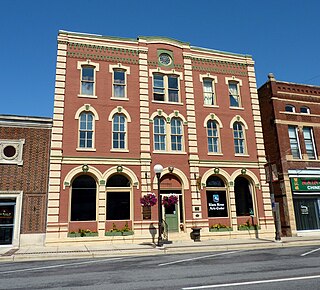
The Grand Hotel is a historic hotel in New Ulm, Minnesota, United States. The private, commercial structure was placed on the National Register of Historic Places (NRHP) on June 21, 1990. The building is notable because of its association with the development of New Ulm's business district and as an example of Italianate architecture in a commercial building.

The Townsend Hotel, also known as the Hotel Townsend, is a historic hotel in Casper, Wyoming. It was renovated and expanded for government use in 2008-2009 and is now known as the Townsend Justice Center.
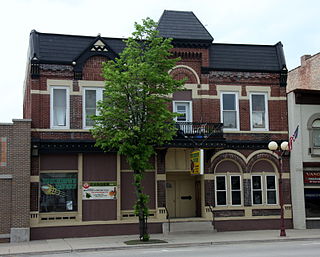
Beastro & Barley, formerly Touchdown Tavern, Town Club Bar or Roper's City Hotel, is a restaurant and bar in a historic hotel building in the Second Empire style at 125 East Main Street in Reedsburg, Wisconsin, United States. The two-storey red brick structure with stone trim and a mansard roof was designed by Edward M. Hackett and constructed in 1886 for $10,000. It includes arched window frames, brick detailing on the facade and a small porch with ornamental metal balustrade on the second floor. It was listed on the National Register of Historic Places for Wisconsin in 1984. It was built by the Reedsburg Building & Lumber Co.

The George W. Palmer House is a historic house located in Chelsea, Michigan.

The Chelsea Commercial Historic District is a historic district located along both sides of Main Street from Orchard to North Street in Chelsea, Michigan; the district also includes the adjacent 100 blocks of Jackson, East Middle, and West Middle Streets, as well as structures on Park, East, and Orchard Streets. It was listed on the National Register of Historic Places in 2011.

The Wolverine Hotel, also known as the Dilworth Hotel or the Wolverine-Dilworth Inn, is a hotel located at 300 Water Street in Boyne City, Michigan. It was listed on the National Register of Historic Places in 1986. It is the only hotel remaining in the Boyne area dating from the turn-of-the-century era when Boyne City was a booming lumber town.

The St. Clair Inn is a hotel located at 500 North Riverside Avenue in St. Clair, Michigan. It was listed on the National Register of Historic Places in 1995.

The Edgewater in Madison, Wisconsin is a hotel which opened in 1948. It was listed on the National Register of Historic Places in 1997 as part of the Mansion Hill Historic District.

The Hotel Magma, is a historic hotel located at 100-130 Main Street between North Magma Avenue and Magma Alley in Superior, Arizona. The hotel's initial structure is a two-store reinforced concrete building at 100 Main Street. An adobe addition was built in 1916 but collapsed in 2007. In 1923 a brick addition, labelled "Macpherson's Hotel Magma" was constructed by John Davey at 130 Main Street. All three structures were designed in the Mission Revival style























